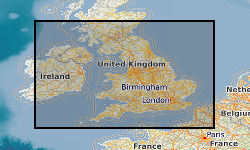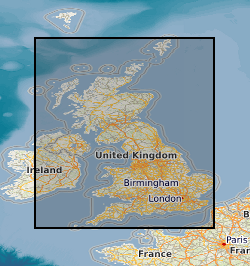continual
Type of resources
Available actions
Topics
Keywords
Contact for the resource
Provided by
Years
Formats
Representation types
Update frequencies
Service types
Scale
-

Tellus Soils For rural soils, samples were collected at an interval of approximately one site per 2 km2 (about one site every 500 acres). Samples were collected from two depths (20 cm and 50 cm) at each site to provide an insight into vertical geochemical variations. The samples were analysed by XRF for Ag, Al2O3, As, Ba, Bi, Br, CaO, Cd, Ce, Cl, Co, Cr, Cs, Cu, Fe2O3, Ga, Ge, Hf, I, In, K2O, La, MgO, MnO, Mo, Na2O, Nb, Nd, Ni, P2O5, Pb, Rb, SO3, Sb, Sc, Se, SiO2, Sm, Sn, Sr, Ta, Te, Th, Tl, TiO2, U, V, W, Y, Yb, Zn, Zr. Au, Pt and Pd were analysed by 10g Fire Assay SO4 by Aqua Regia ICP-MS pH and Loss on Ignition were also recorded. The surveys followed the British Geological Survey's Geochemical Baseline Survey of the Environment (G-BASE) standard developed over many years that defines the specifications for mapping the regional geochemistry of the United Kingdom. For further information visit the Tellus webpages: http://www.bgs.ac.uk/gsni/tellus/
-

1:50,000 maps showing the main geological superficial divisions in Northern Ireland. This series shows the superficial (drift) geology of Northern Ireland at 1:50,000 scale. For each rock unit there is a brief generalised description under the following headings. LEX_D: Description of the selected polygon. LEX_RCS: Map code as it appears on the published 1:250,000 map. RCS_D: Decription of the deposit. VERSION: Version of the data. RELEASED: Date of release/update of the data. Persons interested in the detailed geology of particular sites should consult the latest large-scale maps or the Geological Survey of Northern Ireland at:- Geological Survey of Northern Ireland Colby House Stranmillis Court Belfast BT9 5BF
-

Scanned images of the records of all onshore Northern Ireland boreholes, trial pits, shafts and wells held in the Geological Survey of Northern Ireland archives. The records range from simple single page lithological logs through to hydrocarbon completion reports. Current collection over new records added per annum. Scanning started in 200? and is ongoing with new records being scanned and added to the collection.
-

Data from Marine Conservation Zone (MCZ) surveys are archived in the MEDIN Data Archive Centre (DAC) for Geology and Geophysics at the British Geological Survey. This includes geology (Particle Size Analysis) data and multibeam backscatter data. Data are delivered via the BGS Offshore GeoIndex. Additional data are available on request enquiries@bgs.ac.uk. Other data types are archived with the other MEDIN DACs as appropriate (UKHO DAC for bathymetry data and DASSH DAC for biological data). https://www.gov.uk/government/collections/marine-conservation-zone-designations-in-england.
-

[This metadata record has been superseded, see http://data.bgs.ac.uk/id/dataHolding/13480158] The Geophysical Borehole Log index provides details of all digital geophysical logs available to BGS. The database provides the borehole metadata related to logging and metadata for the logging itself and log data stored in a proprietary hierarchical database system (PETRIS RECALL). Contains most digital geophysically logged bores known to BGS National Geological Records Centre. Scattered distribution of boreholes, locally dense coverage, relatively few logs from Scotland & Central Wales, increasing data density on UK continental Shelf.
-

Mineral Occurrences These data constitute the mineral occurrences in Northern Ireland recorded in Geological Survey of Northern Ireland publications. This index will be updated periodically with the addition of exploration data released from confidentiality under the terms of the Mineral Development Act (NI) 1969. Further information on this data set is available from GSNI (Contact Mark Patton, e-mail: mark.patton@detini.gov.uk).
-

Data generated by a range of scientific projects, including: UK Geoenergy Observatories in Glasgow & Cheshire: UK future energy monitoring and testing, Cardiff Urban Observatory: monitoring geothermal heat recovery and storage project, Seismic monitoring: a network of more than 100+ seismograph stations, River Thames ground water monitoring. BGS collect data from sensors located throughout the UK and beyond.
-

Tellus Drainage Sample Locations Tellus Drainage The drainage dataset contains stream waters and stream sediment analysis and are a combination of two surveys. The first, the G-Base survey, was carried out between 1994 and 1996 in the west of Northern Ireland. In 2005 and 2006 a second survey was carried out as part of the Tellus project in the areas not covered by the original survey. Stream waters The G-Base samples (1994-1996) were analysed for the following anions and fluid parameters: Bicarbonate, Chloride, Fluoride, Nitrate, Sulphate, Dissolved Organic Carbon, Conductivity, pH. Samples were analysed for the tracer elements Ag, Al, Al, As, B, Ba, Be, Ca, Cd, Ce, Co, Cr, Cu, Fe, K, La, Li, Mg, Mn, Mo, Na, Ni, P, Pb, Rb, Sb, Se, Si, Sr, Tl, U V, Y, Zn, Zn, Zr. The Tellus samples (2005-2006) were analysed for the following anions and fluid parameters: Bicarbonate, Bromide, Chloride, Fluoride, Nitrate, Nitrite, Orthophosphate, Sulphate, Dissolved Organic Carbon, Alkalinity, Conductivity, pH. Samples were analysed for the trace elements Ag, Al, As, Au, B, Ba, Be, Bi, Ca, Cd, Co, Cr, Cs, Cu, Fe, Hg, Ho, K, La, Li, Mg, Mo, Mn, Na, Ni, P, Pb, Pd, Pt, Rb, Rh, Sb, Se, Si, Sn, Sr, Th, Tl, U, V, Y, Zn, Zr. The surveys followed the British Geological Survey's Geochemical Baseline Survey of the Environment (G-BASE) standard developed over many years that defines the specifications for mapping the regional geochemistry of the United Kingdom. For further information visit the Tellus webpages: http://www.bgs.ac.uk/gsni/tellus/
-

Radiometrics Tellus Survey 2005 - 2006 Geophysical data were collected in 2005 and 2006 by the Joint Airborne-geoscience Capability (JAC), a joint venture between the Finnish Geological Survey (GTK) and the British Geological Survey (BGS). Magnetic, electromagnetic and terrestrial gamma-radiation (radiometric) data were recorded. Data were acquired for 80,458 line km of survey. Flight lines were spaced 200 m apart in the direction 165-345 degrees. The survey was flown with a nominal ground clearance of 56 m in rural areas and 240 m in urban areas, with sample intervals of 7 m (magnetics), 17.5 m (electromagnetics) and 70 m (gamma radiation).
-

Electromagnetics Tellus Survey 2005 - 2006 Geophysical data were collected in 2005 and 2006 by the Joint Airborne-geoscience Capability (JAC), a joint venture between the Finnish Geological Survey (GTK) and the British Geological Survey (BGS). Magnetic, electromagnetic and terrestrial gamma-radiation (radiometric) data were recorded. Data were acquired for 80,458 line km of survey. Flight lines were spaced 200 m apart in the direction 165-345 degrees. The survey was flown with a nominal ground clearance of 56 m in rural areas and 240 m in urban areas, with sample intervals of 7 m (magnetics), 17.5 m (electromagnetics) and 70 m (gamma radiation).
 NERC Data Catalogue Service
NERC Data Catalogue Service